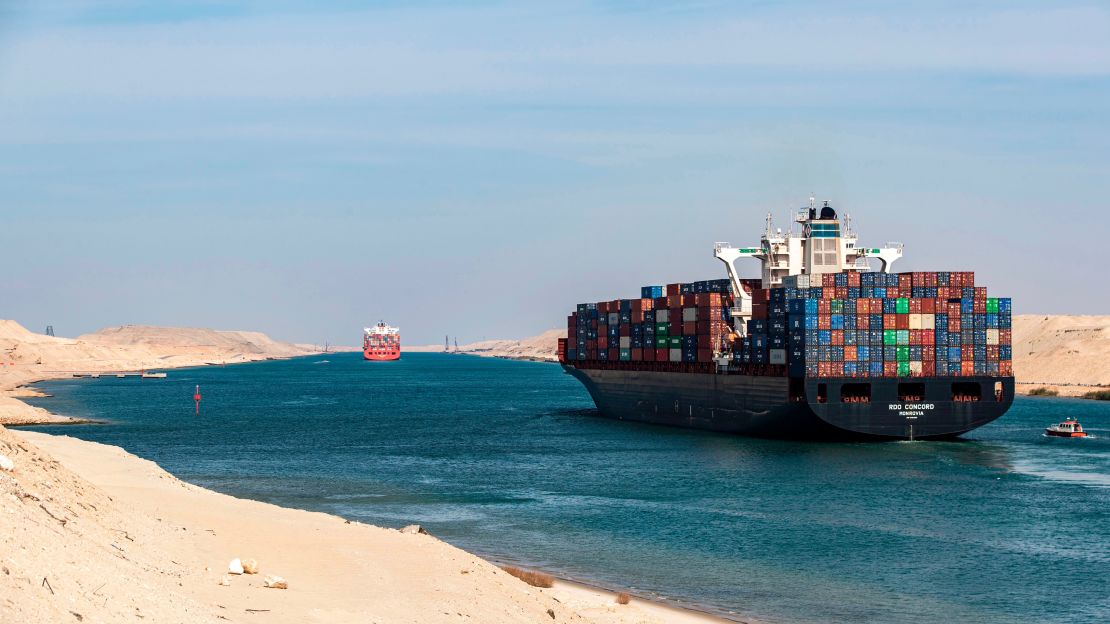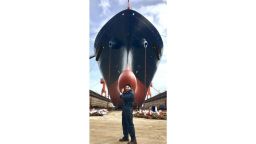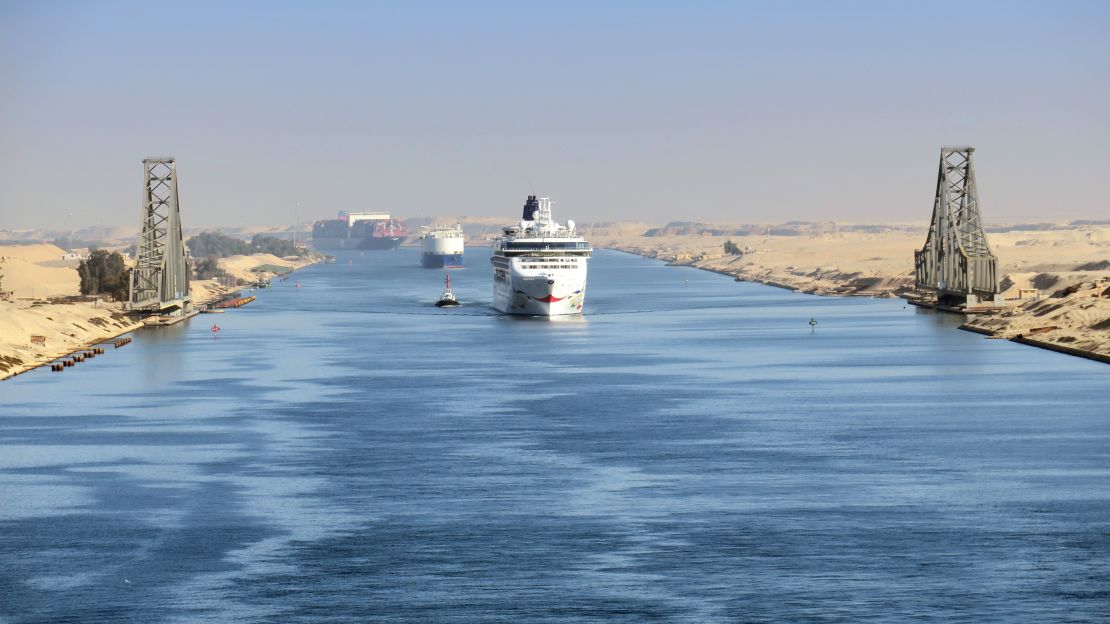The emergency stop is a familiar maneuver for most motorists. A hazard presents itself in front of the moving vehicle, the driver hits the brakes and grips the steering wheel, the car screeches to a halt, hopefully under full control.
But what happens when the vehicle you’re driving is the size of a small city and doesn’t actually come equipped with brakes?
That’s the scenario facing those at the helms of the hundreds of gigantic container and cruise ships in our seas and waterways.
The maneuverability of these titans of the oceans hit the headlines when a container ship as long as the Empire State Building is tall became stuck in the Suez Canal, one of the world’s most important waterways.
The Ever Given rammed into the side of the waterway on March 23 when, according to the Suez Canal Authority, it was engulfed by 40-knot winds and low visibility caused by a sandstorm. Amid the struggle to push the ship back on course, scores of vessels became stuck in a marine traffic snarl up.
Given the level of traffic typically seen in the Suez Canal — when there’s no pandemic this can be an average of 106 towering container vessels and hulking cruise ships each day — it’s perhaps surprising that such an incident doesn’t happen more often.
So what is it really like to steer the world’s biggest ships through the Suez and beyond? CNN Travel spoke to expert mariners to learn more.
A container ship captain’s perspective

Captain Yash Gupta helms container vessels that cross the world’s oceans. He’s been working at sea for almost 20 years.
Gupta calls seafaring life “unpredictable, but very interesting.”
“If you are at sea under normal operations it feels quite relaxed,” he tells CNN Travel.
But, he adds, you never know what’s going to happen next.
“One day, you see the water is just calm and the ship is rock steady. You wake up in the morning and you see it’s a storm coming in and waves of maybe five meters, six meters, eight meters. You never know.”
The key, he says, is to plan. On board, Gupta heads up around 20 to 25 people at any given time, with crew contracts ranging from four to nine months.
Together with his navigation team, Gupta carefully maps out the route before the voyage begins, factoring in tidal and weather conditions.
Wind is a particularly important consideration for container ships because the stacked containers lends them a dizzying height.
“So you can imagine it’s just like a solid wall, which is faced against the wind,” says Gupta.
He says the wind effect is uncontrollable because the ship is in water. It’s not possible to hit the brakes in the same way you’d stop a moving car.
In pictures: Container ship freed in Suez Canal
And just how quickly can you bring a container ship to a stop?
To answer this question, Gupta points to the extremely high demand for shipping cargo.
“Look around yourself, wherever you are sitting – everything you see, or you touch, has been on a ship in its life.”
He says this high demand means container ships are built to accommodate speeding up and slowing down in as short amount of time as possible, to avoid delays.
But the scale of the vessels means the numbers still seem big.
A container ship going from top speed to stop takes about 1.8 miles and between 14 to 16 minutes, says Gupta.
Steering mechanisms vary from ship to ship, with some steered by dials, buttons and levers, but steering wheels are still common – just not the giant wooden ones that once maneuvered sailing ships.
“It’s a steering wheel with a lot of electronics involved,” explains Gupta. “When the wheel is turned it gives electronic signals to the rudder which turns as per the command given.”
When navigating the Suez, ships travel in convoy and must sail at more or less the same speed as the vessel they’re following for the entirety of the roughly 12 to 16 hours it could take to transit the canal.
“You can’t just start increasing your speed. Otherwise, the distance between the two vessels will become less and less and less, and then you will ultimately go and collide,” says Gupta.
Whether a vessel approaches the Suez Canal from the north or south entryway, it also can’t proceed until at least one pilot representing the Suez Canal Authority comes on board.

“They have expertise in transiting through the Suez Canal,” explains Gupta. “This pilot has to be on board the vessel and he navigates the vessel. He basically assists the captain.”
However, the overall responsibility for safely transiting the vessel still lies with the captain, says Gupta.
Crucially, the Suez pilots are experts in the area’s topography. They know the tides, they know the water depth, they’re familiar with the width of the canal.
Once ships are transiting the canal, they generally cannot overtake one another, although in some spots the canal is wider, and vessels are permitted to overtake.
Pilots will communicate with one another via radio communication to discuss these maneuvers.
“The pilot says to the other vessel: ‘Okay, I’m going to overtake you, you give me some room, you go on one side or you want to increase the speed, decrease the speed,’” explains Gupta.
Also involved in proceedings are what Gupta calls the Suez Canal’s equivalent of air traffic control, a subsidiary of the Suez Canal Authority that monitors vessel traffic.
“They have a bigger radar and a bigger navigation equipment. They are monitoring the movement of all the ships as a whole and they coordinate the activities.”
Tug boats helped free the Ever Given, liberating it on March 29 after six days of being stuck. Gupta says these small vessels are often used to help large ships navigate the Suez.
“There are some areas in the canal which are narrower than the rest,” he says. “Tugs are usually used as ‘escorts’ in such areas for big ships.”
The tug boats travel in tandem with the larger ship and remain available to help should any issues arise.
Cruise ship perspective
Cruise ships transiting the Suez Canal or other narrow waterways experience many of the same challenges as container ships.
For one, they’re also extremely tall.
“The higher the vessel, the more windage, the more susceptible you are to the effects of the wind, so that all that has to be taken into consideration,” says Captain David Bathgate, who heads up ships for Seabourn Cruise Line, a luxury cruise line owned by Carnival.
Bathgate has decades of seafaring experience under his belt, having worked on general cargo vessels, bulk carriers, container ships and oil tankers over his career.
He’s held the title of captain for the past two decades.
“Being in charge of the vessel is a hugely rewarding and satisfying experience,” Bathgate tells CNN Travel.
Like Gupta, he works with his on board team to create a voyage plan.
Each plan, says Bathgate, encompasses four steps: appraisal, planning, execution, and monitoring.
Appraisal, he explains, involves ensuring the team has the right charts, navigational warnings and up-to-date meteorological conditions.
“Then you’ve got the planning, constructing the route itself through the various sections,” he explains. “Then you’ve got the execution, actually doing the job, taking the vessel there.”
Finally, monitoring involves keeping tabs on the vessel en route and making sure the ship is on track, and taking any corrective actions if needed.
Bathgate says each voyage plan will be checked by at least four people, including senior navigator officers and an environmental officer.
Before navigating a narrow passage, such as the Suez, Bathgate’s team will make sure they are conscious of the waterway’s depth, width and what he calls, “any additional navigational hazards within.”
These could include shallow areas, bends, corners or banks.
While those topographical conditions aren’t likely to change, unanticipated weather can have an unexpected effect.
“The weather is one of the perhaps one of the most important aspects of these passages in constrained waters, in terms of wind speed, and visibility,” says Bathgate.
“In the Suez, for example, one of the key hazards would be sandstorms, so very quickly and without warning, very strong winds can creep up with significant quantity of sand and reducing visibility.”

Bathgate also notes how ships transit the canal in a numbered convoy, so when they approach the canal, they anchor and await confirmation of their time slot.
“Invariably cruise ships, we are generally given the number one in the convoy and we’re quite often followed by the large container ships which are on a critical timeline,” he says.
Container ship captain Gupta explains that cruise ships usually get priority because of their numbers of passengers and because they are working within tight timeframes. This is the case not just in the Suez, but in other waterways, he says.
Usually two or three Suez pilots will board a cruise ship to help with transit, and Bathgate notes sometimes pilots may switch halfway through.
And so just how easily can a cruise ship slow down or speed up? The numbers are pretty similar to a container vessel.
“From full speed, just putting the engines to stop and letting the ship coast as it were, it would take 15 minutes, and 1.75 miles, for us to stop,” says Bathgate.
“However, if we wanted to do a crash stop by putting the engines full astern, then it would take us just under five minutes, and the distance we would travel is only three quarters of a mile. So for the size of vessel, that’s quite impressive figures.”
Passenger perspective
While cruise captains are hard at work ensuring smooth passage through the Suez, passengers enjoy watching the convoy from their boardroom balconies.
Pam Broadhead transited the Suez Canal in November 2019, on Marella Discovery, an 11-deck TUI cruise ship. The vessel, traveling from Malaga in Spain to Dubai, entered from the north entryway and traveled south.
“Our ship was the first ship to sail through so it was an early alarm to be on deck to see the sunrise,” she tells CNN Travel, recalling passengers drinking coffee and eating croissants as they watched the sun appear on the horizon.
“After seeing the sunrise we sat on our balcony with coffees watching as the boats (all of them container ships) passed by us in a constant convoy. Most fully laden with containers.”
Occasionally, the passengers spotted local fishing boats, dwarfed by the Marella Discovery and most other ships in the convoy.
“Think they quite enjoyed waving to all of us and us them,” Broadhead says.
Broadhead and her husband had hoped for a good view of the Mubarak Peace Bridge – a road bridge that crosses the canal, and links Asia and Africa – but early morning fog impacted the range of vision from the ship, which meant this wasn’t possible.
“But just going underneath it felt quite moving. I think being of a generation that is aware of the Suez crisis possibly made it more of a moment,” she says.
Misty conditions impacted a significant section of the passage, Broadhead recalls.
“At one point, visibility was barely a few meters into a bank of white cloud, making it impossible to see the canal edges or even the water or other ships but we continued silently cruising through with all the other ships following,” she says.
“Thankfully, the fog dissipated around the halfway point and there was plenty to see from there on.”
When the ship reached the southern exit, it was held for a while before leaving the canal. Broadhead and her fellow passengers were able to watch the canal voyage come to a close as the sun set over the Gulf of Suez.





































